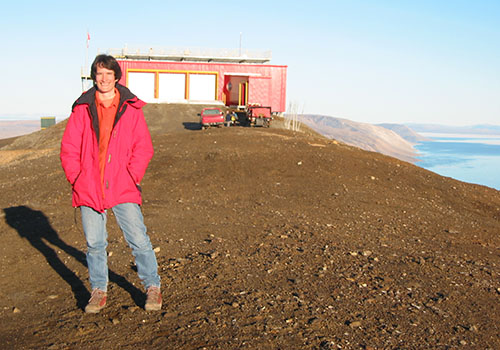When Kimberly Strong joined the Department of Physics in the Faculty of Arts & Science in 1996, she was the only female faculty member at the time — something that was not uncommon in a field dominated by male scientists.
In July 2019, Strong began a five-year term as the chair of the department, becoming the first female to hold that position.
Strong is an atmospheric physicist who uses ground-based, balloon-borne and satellite instruments to study atmospheric ozone chemistry, climate and air quality. Her research takes her as far north as Nunavut where she studies the polar atmosphere.
In September 2019, she was named a fellow of the prestigious Royal Society of Canada.
Sheela Manek of the Department of Physics spoke to Strong about her research and about becoming chair.
Your PhD from Oxford was in atmospheric physics. Why did you choose this branch of physics?
When I started looking into possible topics for graduate studies, I was most interested in fields that related physics to the wider world: atmospheric physics, geophysics, astrophysics — and even archaeology and physics. I chose to specialize in atmospheric physics because it was both fascinating and so important to life on Earth. It’s essential that we understand what is happening in our atmosphere now and in the past and how both natural causes and human activities may lead to future changes.
Why is your atmospheric research so important?
The overall goal of my research is to improve our understanding of the chemical and physical processes that determine atmospheric composition and drive atmospheric change, knowledge that is needed for informed policy-making.
Scientific research into the causes and consequences of climate change, air pollution and ozone depletion is essential for society to understand what’s happening to our environment, why it’s happening and how we might respond. To investigate these topics, my group develops and uses spectroscopic instruments and data analysis tools to measure atmospheric trace gas concentrations.
You are one of founders of the Canadian Network for the Detection of Atmospheric Change (CANDAC) — which established the Polar Environment Atmospheric Research Laboratory (PEARL) at Eureka, Nunavut. What research is your group doing there?

I began research at Eureka in 1999, with a program of spring campaigns that still continue; these have generated a unique dataset for the study of processes and long-term trends in the high Arctic. CANDAC established PEARL in 2005 and I am currently co- principal investigator. There are more than 20 instruments installed at PEARL and my students and postdoctoral fellows run four of these. My group measures a suite of trace gases, contributes these measurements to international observing networks and uses them to validate new data products from satellite missions and to study the Arctic atmosphere.
For example, in 2011, we captured the largest stratospheric ozone depletion event seen in the Arctic. We have tracked plumes from the burning of organic material and recently published the first long-term study of ammonia in the Arctic, showing that the 2017 North American wildfires resulted in an increase of ammonia and other trace gases in the high Arctic. We also use our PEARL measurements to study a variety of other phenomena, including Arctic water vapour, the carbon cycle, long-term trends and clouds.
What is coolest thing about working at PEARL?
The low temperature, of course! Visiting PEARL is a truly unique experience. It’s a two-day trip from Toronto and once there, you feel like you are in a very special place, knowing that it is the most northerly permanent outpost in Canada after Alert which is about 500 kilometres closer to the North Pole. In summer, there is 24-hour daylight and a surprising abundance of small Arctic wildflowers; while in winter, the 24 hours of darkness and temperatures of -50 C really make visiting PEARL a polar adventure.
What most excites you about your role as chair?
I am honoured to have been asked to serve as chair for the next five years. Since arriving here as an assistant professor in 1996, I have benefitted greatly from being a member of the department and so I am excited to now have the opportunity to contribute to its future development and success. We are blessed with excellent students and postdocs, dedicated staff and outstanding faculty who work at the forefront of physics across many fields.
What does it mean to you to be the first female chair?
U of T has many capable female academic administrators, some of whom I worked with while I was director of the School of the Environment. Joining their ranks as chair therefore doesn’t seem particularly momentous. On the other hand, I’ve been told that there have only been a very few female physics chairs in Canada, so I feel a certain responsibility to do a good job!
I was the only female professor in the physics department when I was hired. I’m glad that we have managed to increase this by about an order of magnitude over the last two decades, as well as increasing diversity more broadly, but there is still room for improvement. As a female chair, I hope that I can bring a new perspective to the role and directly or indirectly, provide encouragement for others.

